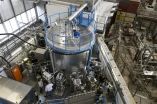(Press-News.org) PHILADELPHIA – Even if they don't show signs of infection, college athletes who play football, soccer and other contact sports are more likely to carry the superbug methicillin-resistant Staphylococcus aureus (MRSA), suggests a study on MRSA and athletes, which is being presented at IDWeek 2014™. This puts them at higher risk for infection and increases the likelihood of spreading the bug, which can cause serious and even fatal infections. The study is the first to observe college athletes who are not part of a larger MRSA outbreak.
Contact sport athletes were more than twice as likely as non-contact athletes to be colonized with MRSA, meaning they carried the bug on their bodies, usually in their noses and throats. Throughout the two-year study, colonization with MRSA ranged from 8 to 31 percent in contact sports athletes, compared to 0 to 23 percent of non-contact athletes. From 5 to 10 percent of the general population is colonized with MRSA.
"This study shows that even outside of a full scale outbreak, when athletes are healthy and there are no infections, there are still a substantial number of them who are colonized with these potentially harmful bacteria," said Natalia Jimenez-Truque, PhD, MSCI, research instructor, Vanderbilt University Medical Center, Nashville, Tenn. "Sports teams can decrease the spread of MRSA by encouraging good hygiene in their athletes, including frequent hand washing and avoiding sharing towels and personal items such as soap and razors."
Researchers analyzed the time it took for college athletes to be colonized with Staphylococcus aureus (staph), including MRSA, the antibiotic-resistant variety, and how long they carried it. The study followed 377 male and female Vanderbilt University varsity athletes playing 14 different sports, incuding 224 who played contact sports such as football, soccer, basketball and lacrosse, comparing rates of colonization with staph to 153 who played non-contact sports, including baseball, cross country and golf. Each athlete had monthly nasal and throat swabs over the course of two academic years. The study also found contact athletes acquired MRSA more quickly and were colonized longer than non-contact athletes.
MRSA is a leading cause of skin and soft tissue infections, which often heal on their own or are easily treated. But the invasive form of MRSA can cause pneumonia and infections of the blood, heart, bone, joints and central nervous system, and kills about 18,000 people every year. Invasive MRSA is dificult to treat because standard antibiotic therapy may be ineffective, and physicians often must turn to powerful antibiotics delivered through an I.V.
Athletes in contact sports are at higher risk for getting colonized with or infected by MRSA because they have skin-to-skin contact and often have cuts and scrapes that allow the bug to enter the body.
Researchers said athletes can reduce the risk of spreading the bug by covering any open wounds, regularly washing their hands, showering after all practices and games, and not sharing razors and other personal equipment. Athletes with scratches and cuts should not practice or play in games, towels and clothes should be washed daily, and shared equipment and facilities should be cleaned routinely. While keeping equipment clean is important, researchers found little staph in the athletic environment, such as the locker room and weight room, suggesting that MRSA is most often spread person to person, Jimenez-Truque said.
"Staph is a problematic germ for us – always has been, always will be – and we need to do all we can to reduce the risk of infection in those at highest risk, such as college athletes," she said.
INFORMATION:
About IDWeek
IDWeek 2014TM is the annual meeting of the Infectious Diseases Society of America (IDSA), the Society for Healthcare Epidemiology of America (SHEA), the HIV Medicine Association (HIVMA) and the Pediatric Infectious Diseases Society (PIDS). With the theme "Advancing Science, Improving Care," IDWeek features the latest science and bench-to-bedside approaches in prevention, diagnosis, treatment, and epidemiology of infectious diseases, including HIV, across the lifespan. IDWeek 2014 takes place October 8-12 at the Pennsylvania Convention Center in Philadelphia. For more information, visit http://www.idweek.org.
EAST LANSING, Mich. --- The sexes show stark differences in how they evaluate art, finds a new study co-authored by a Michigan State University marketing scholar.
Men seem to focus more on the artist's background and authenticity, while women pay more attention to the art itself.
The study, which appears in the journal Psychology & Marketing, is the first to investigate how important an artist's "brand" is to average consumers when they appraise art. Turns out, that personal brand is very important, a finding that has implications for the $64 billion art market and ...
This news release is available in German.
It has been known for several years that sulfuric acid contributes to the formation of tiny aerosol particles, which play an important role in the formation of clouds. The new study by Kürten et al. shows that dimethylamine can tremendously enhance new particle formation. The formation of neutral (i.e. uncharged) nucleating clusters of sulfuric acid and dimethylamine was observed for the first time.
Previously, it was only possible to detect neutral clusters containing up to two sulfuric acid molecules. However, ...
New Rochelle, NY, October 9, 2014—Laser Solid Forming (LSF) is an innovative method for direct fabrication of metallic components in additive manufacturing. Renowned researchers Weidong Huang and Lin Xin, from China's Northwestern Polytechnical University, Shaanxi, describe their progress and applications with LSF technology and the excellent mechanical properties of the metallic parts produced in a Review article in 3D Printing and Additive Manufacturing, a peer-reviewed journal from Mary Ann Liebert, Inc., publishers. The article is available free on the 3D Printing ...
WASHINGTON, Oct. 9, 2014—Some people might consider mucus an icky bodily secretion best left wrapped in a tissue, but to a group of researchers from the University of North Carolina at Chapel Hill, snot is an endlessly fascinating subject. The team has developed a way to use gold nanoparticles and light to measure the stickiness of the slimy substance that lines our airways. The new method could help doctors better monitor and treat lung diseases such as cystic fibrosis and chronic obstructive pulmonary disease.
The research team will present their work at The ...
Researchers from the National Cancer Institute report that decaffeinated coffee drinking may benefit liver health. Results of the study published in Hepatology, a journal of the American Association for the Study of Liver Diseases, show that higher coffee consumption, regardless of caffeine content, was linked to lower levels of abnormal liver enzymes. This suggests that chemical compounds in coffee other than caffeine may help protect the liver.
Coffee consumption is highly prevalent with more than half of all Americans over 18 drinking on average three cups each day ...
VIDEO:
The 'heart attack in a dish' experiment reveals that the mitochondria--or cellular powerhouses--of heart muscle cells flicker and oscillate following heart attack and disrupt the heart's entire electrical system...
Click here for more information.
Heart attack survivors often experience dangerous heart rhythm disturbances during treatment designed to restore blood flow to the injured heart muscle, a common and confounding complication of an otherwise lifesaving intervention. ...
This news release is available in German. The Ebola epidemic in West Africa appears to be spiralling out of control. More than ever, local and global health authorities want to know how the epidemic will develop and, above all, how to prevent it from spreading further. Certain parameters help them to determine this, such as the reproductive number, which is the average number of infections caused by a single infected individual. The incubation and infectious periods are also highly relevant; i.e. the time from infection to the onset of symptoms and the time from onset ...
Antimicrobial usage in animals in Denmark continued to increase in 2013 – mainly due to an increased use in pigs. However, antimicrobial use in pigs is still 12% lower than in 2009. In general, livestock received very little of the critically important antimicrobials, which are used to treat humans. These findings appear in the annual DANMAP report from Statens Serum Institut and the National Food Institute, Technical University of Denmark. DANMAP is the Danish integrated antimicrobial resistance monitoring and research programme.
In 2013, the total use of antimicrobials ...
This news release is available in German. Only recently, the UN Climate Summit came together in New York to further address the necessary measures to protect the Earth from a dramatic climate change. It has long been recognised that an increase of the average temperature will cause rising oceans and thus flooded landscapes. Particularly, regions close to the coasts are endangered. While it is well known that climate change has increased average temperatures, it is less clear how temperature variability has altered with climate change.
Postdoctoral fellow George Wang, ...
The risk of having another stroke is higher if patients, after dilation of their blood vessels in the brain, not only receive clot-inhibiting drugs, but also have small tubes called stents inserted. However, studies have provided no hint of a benefit from stenting, which is also referred to with the abbreviation "PTAS". This is the conclusion reached in the rapid report of the German Institute for Quality and Efficiency in Health Care (IQWiG), as published on 9 October 2014.
Stents are supposed to prevent restenosis
Blood vessels in the brain that are narrowed or blocked ...



